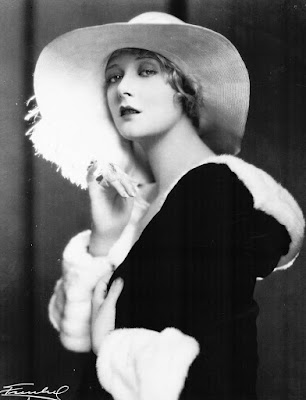1901-1991
Silent film actress Vilma Bánky was born Vilma Koncsics (sometimes credited, of course, as Koncsics Vilma) on this day in Nagydorog, Austria-Hungary (now located in the Republic of Hungary) to an ethnic Hungarian father and a German mother. Of course she is a very familiar face to even causal film fans due to her acting opposite the Latin Lover himself, Rudolph Valentino in two films; but, unknown to most, she started her film career back in Hungary (albeit in an Austrian/German production). As an infant, her family was officially relocated to Budapest (her father was an upper level police officer who worked directly for the Emperor), growing up there, she had intended on becoming a secretarial agent, but while in school training as such, she was noticed for her striking looks and offered a job in a film. That film was the now lost Im letzten Augenblick, it had Austrian German intertitles and directed by German writer/director Carl Boese. She did not appear in another film until she took the lead in a Béla Balogh film Veszélyben a pokol in 1921. She would bounce around in the continental European film market, including one of Géza von Bolváry's Hungarian films before his departure for Germany: Tavaszi szerelem (1921). Without a doubt, her most high profile film before her own departure for Hollywood was King of the Circus, a 1924 Austrian comedy starring Max Linder (who has been compared to Charlie Chaplin and Buster Keaton). In 1925, she was "discovered" by studio head Samuel Goldwyn while on a trip to Budapest and signed to an extremely lucrative contract with his company. He went home to drum up an reputation for her and she made an appearance in one last European film, The Lady from Paris (December 1924), a German picture directed by Manfred Noa (she also appeared in another Noa film--Soll man heiraten?--but the film was not released until October of 1925). Goldwyn's company had done such a good job of promoting her as the next big thing, that when she arrived in the United States in 1925, there was immediately a ton of press and publicity, hailing her as "The Hungarian Rhapsody." Her first film in the U.S. was a resounding success for Goldwyn and George Fitzmaurice's companies. The Dark Angel (September 1925) was based on a popular play and had Bánky starring opposite Ronald Colman and directed by Fitzmaurice himself. Her next two films were the very famous appearances with Valentino. The first was The Eagle, directed by Clarence Brown, it was based on a Pushkin novel and released in November of 1925. Following directly after, was The Son of the Sheik (September 1926), sequel to Valentino's 1921 blockbuster The Sheik, the film was another George Fitzmaurice directed effort and famously became Valentino's last film. As for Bánky, Valentino was the one who selected her for the roles personally; it seems that he was genuinely fascinated with her. For her part, she followed up her role in this--now one of the most famous of silent films--with a return to acting with Ronald Colman in the western The Winning of Barbara Worth (1926). The two films were shot virtually at the same time. She would continue to act opposite Colman through 1928, including in her fist appearance in a film with sound. Two Lovers (March 1928) was a historical romance film that was directly produced by Goldwyn and directed by Fred Niblo; it was released as both a partial silent and a fully silent film and marked her last role acting with Colman. Unfortunately, both versions are now sadly considered lost. She made just two more films in the decade--both partial silents. The last of them--This Is Heaven--was a romantic comedy filmed in New York City and released in June of 1929. She made just three films in the 1930's, two of them directed by Victor Sjöström; his romantic drama A Lady to Love (1930) was her first full sound film. Her transition to sound simply did not fly however; her extremely thick Hungarian accent was a career-ender. Her last film was in the German language film The Rebel in 1933 (she was fluent in German from a young age). She then retired to a long life filled the charitable works and golf....lots and lots of golf (she was, in fact, a championship player in 1950's and she played well into her 80's). In June of 1927, she married fellow actor Rod La Rocque, and huge ceremony, throwing one the most elaborate receptions that Hollywood as yet witnessed. Theirs was not a typical Hollywood marriage however, as they remained married until his death in 1969. Bánky herself passed away on the 18th of March in 1991 at the age of 91 (note: some sources put her birth year in 1898--if she were born in that year, she would have made her 93 at the time of her death). She was cremated and her ashes were scattered at sea at the very spot where her husband's ashes had been scattered some 22 years prior. Bánky was also one of the most fashionable women in films of the 1920's, both on and off the screen.










No comments:
Post a Comment